
Atriplex is a plant genus of 250–300 species, known by the common names of saltbush and orache. It belongs to the subfamily Chenopodioideae of the family Amaranthaceae s.l.. The genus is quite variable and widely distributed. It includes many desert and seashore plants and halophytes, as well as plants of moist environments. The generic name originated in Latin and was applied by Pliny the Elder to the edible oraches. The name saltbush derives from the fact that the plants retain salt in their leaves; they are able to grow in areas affected by soil salination.
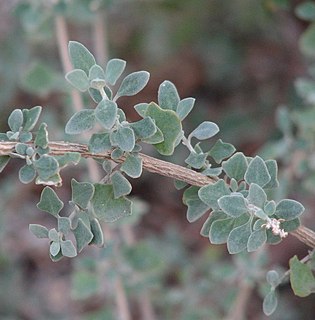
Atriplex amnicola, commonly known as river saltbush or swamp saltbush, is a species of shrub in the family Amaranthaceae. Endemic to Western Australia, it is native to the floodplains of the Murchison and Gascoyne Rivers.

Halimione portulacoides or sea purslane (2n=36) is a small greyish-green shrub widely distributed in temperate Eurasia and parts of Africa.

Atriplex semibaccata, the Australian saltbush, berry saltbush, or creeping saltbush, is native to Australia, commonly found in coastal regions from South Australia all the way up to Cardwell in Queensland. It is a prostrate growing ground cover plant of the family Amaranthaceae that grows to around 180 cm wide, and flowers year round. Leaves small, olive to grey-green. Insignificant flowers, in small clusters in leaf axil. Flowers during summer. Fruit is flattened, diamond-shaped, orange to red. It is tolerant of saline and dry conditions making it commonly used as an animal feed source in poorer agricultural areas: it is grazed by livestock, and birds are fond of its fruits. It is also a good species for erosion control.

Atriplex cinerea, commonly known as grey saltbush, coast saltbush, barilla or truganini, is a plant species in the family Amaranthaceae. It occurs in sheltered coastal areas and around salt lakes in the Australian states of Western Australia, South Australia, Tasmania, Victoria and New South Wales.
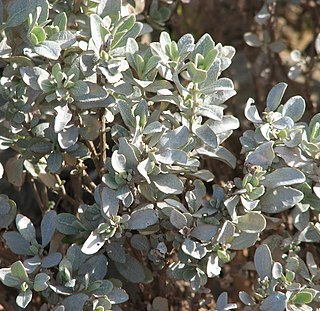
Atriplex vesicaria, commonly known as bladder saltbush, is a species of saltbush endemic to Australia.
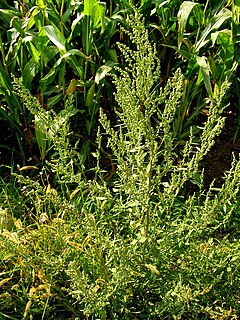
Atriplex patula is a ruderal, circumboreal species of annual herbaceous plants in the genus Atriplex naturalized in many temperate regions. Atriplex patula is a member of the family Chenopodiaceae.
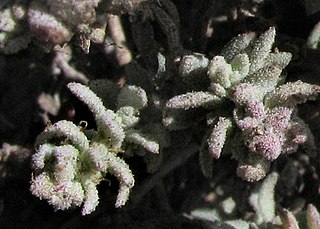
Extriplex californica is a plant species known by the common name California saltbush or California orache. Formerly, it was included in genus Atriplex. It is native to coastal California and Baja California, where it grows in areas with saline soils, such as beaches and salt marshes.

Atriplex coronata is a species of saltbush known by the common name crownscale. It is endemic to California.
Extriplex joaquinana is a species known by the common name San Joaquin saltbush. It was formerly included in genus Atriplex.
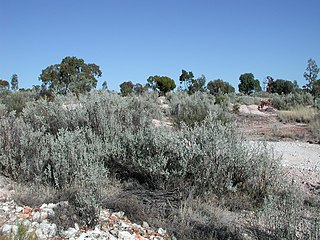
Atriplex nummularia is a species of saltbush from the family Amaranthaceae and is a large woody shrub known commonly as oldman saltbush. A. nummularia is native to Australia and occurs in each of the mainland states, thriving in arid and semi-arid inland regions.
Atriplex spinifera is a species of saltbush, known by the common names spiny saltbush and spinescale saltbush.

Atriplex watsonii is a species of saltbush known by the common name Watson's saltbush, or Watson's orach. It is native to the coastline of California and Baja California, where it grows in coastal areas with saline soils, such as salt marshes and beach scrub, with other halophytes such as saltgrass. It extends inland in the Los Angeles Basin, and along the Santa Ana River.

Suaeda fruticosa is a species of flowering plant in the family Amaranthaceae. It is a small shrub, with very variable appearance over its wide range. It is a halophyte, and occurs in arid and semi-arid saltflats, salt marshes and similar habitats.

Halimione is a plant genus from the subfamily Chenopodioideae of the family Amaranthaceae. It is a sister genus of Atriplex and has sometimes been included in this genus.

Extriplex is a plant genus in the subfamily Chenopodioideae of the family Amaranthaceae. It has been described in 2010 and comprises two species, that were formerly included in genus Atriplex. They are restricted to the California Floristic Province.

Stutzia is a plant genus in the subfamily Chenopodioideae of the family Amaranthaceae. It was described in 2010, replacing the illegitimate name Endolepis. It comprises two species, that have also been included in the genus Atriplex.
Proatriplex is a monotypic plant genus in the subfamily Chenopodioideae of the family Amaranthaceae, with the only species Proatriplex pleiantha. It is known by the common names Four-corners orach and Mancos shadscale. It occurs in the Navajo Basin of Arizona, Colorado, New Mexico, and Utah.

Atripliceae are a tribe of the subfamily Chenopodioideae belonging to the plant family Amaranthaceae. Atriplex is the largest genus of the family. Species of Atripiceae are ecologically important in steppe and semi-desert climates.

Dissocarpus paradoxus is a shrub species of inland Australia, also known by the common names of cannonball burr or curious saltbush.
















